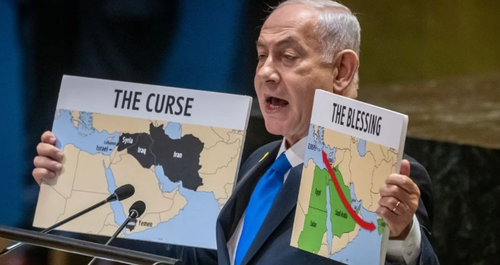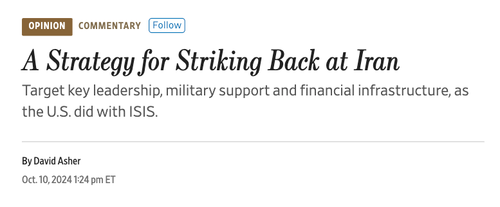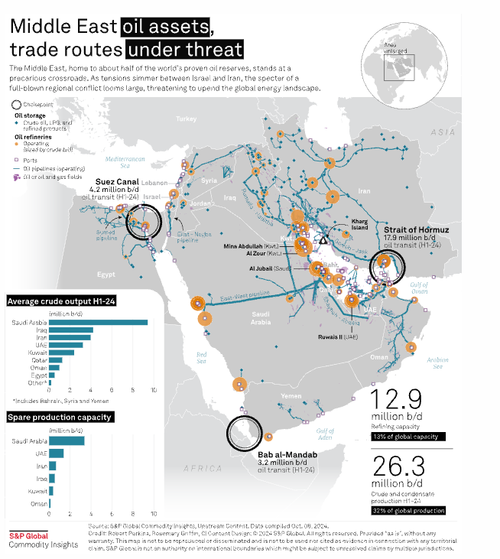Ex-State Department Official Who Blew Up ISIS’s Bank Reveals Roadmap For “Striking Iran”
Top Israeli officials, including senior ministers and Prime Minister Benjamin Netanyahu, met on Thursday to outline a war strategy for Israel’s retaliation against Iran, according to the New York Times, citing two officials who requested anonymity due to the private nature of the discussions. The move comes in response to Iran’s bombardment of Israel early last week, which involved up to 200 ballistic and hypersonic missiles. This tit-for-tat escalation could spiral into a much larger and broadening conflict across the Middle East.
NYT cited Israeli officials, who have warned that coming retaliation for last week’s missile barrage “will be more severe.” President Biden this week spoke with Netanyahu, the first conversation in months, about Israel’s pending retaliation strike against Iran.
Last Thursday, Biden was asked by MSM reporters outside the White House if he would support Israel striking Iran’s critical oil export facilities. The president said, “We’re discussing that.”
President Biden was asked about Israel striking Iran’s oil facilities this morning. He said:
“We’re discussing that. I think that would be a little … anyway … Nothing will happen today.” pic.twitter.com/6AV2fxKHf4
— unusual_whales (@unusual_whales) October 3, 2024
Remember, on Sept. 27, Netanyahu told the United Nations General Assembly, “The curse of Oct. 7 began when Hamas invaded Israel from Gaza, but it didn’t end there. Israel was soon forced to defend itself on six more war fronts organized by Iran.”
We have detailed in multiple notes how the most likely high-value assets that IDF jets (F-35s) could hit first would be Iran’s ability to export crude and crude energy products:
-
Oil Surges On Report Biden “Discussing” Strike Of Iranian Oil Facilities
-
Israel Mulling Attacks On Iran Energy Sites Despite Biden Objections, Oil Spikes
Providing more color on what a potential IDF strike on Iran would look like is David Asher, a senior fellow at the Hudson Institute and a former US State Department official who has worked on counter-terrorism operations in the Middle East.
Asher penned an op-ed in the WSJ on Thursday titled “A Strategy for Striking Back at Iran“…
Asher noted:
The strategy Israel has successfully implemented against Hezbollah must now be applied against Tehran directly. The regime is the puppeteer behind Oct. 7 and the multifront attacks against Israel.
He explained:
Israel’s most effective course of action would be to target key leadership, military support and financial infrastructure of the Islamic Revolutionary Guard Corps and the Intelligence and Security Ministry. That would weaken the regime’s pillars while avoiding direct harm to civilians, which could otherwise foster sympathy for the regime. Combined with attacks on Iran’s external oil-export capacity to deprive the regime of its financial lifeblood, a top-down leadership-focused approach would pressure the regime without disrupting essential domestic services.
Israel should first neutralize the immediate missile threat posed by the regime. Striking Iran’s leadership and nuclear facilities without simultaneously addressing Iran’s offensive missile capabilities would allow the regime to retaliate aggressively. Iran knows this, which explains why its rulers are posting web images of their subterranean “missile cities.” Next, Israel must attack the regime’s headquarters, command facilities and military. No key Iranian leaders should be spared. The precision killing of Hamas leader Ismail Haniyeh in a Tehran apartment demonstrates that Israel can strike anyone, anytime and anywhere.
Then Iran’s military training camps on the Iraq border should be smoked. For decades, these camps have been used to train Iranian, Hezbollah, Hamas and Iraqi special-group operatives for campaigns against Israel, U.S. forces in Iraq and Syria, and global antiterrorist operations. After that Iran’s central bank and oil export facilities should be destroyed.
Asher pointed out he was critical in counter-terrorism operations against ISIS’s central bank and cash distribution centers across Mosul, Iraq, in 2015-16.
He said the combination of kinetic warfare and economic warfare could be a winning strategy for Israel to dismantle Tehran’s financial apparatus, adding that only after “disrupting command, control, and financial and logistical infrastructure should Israel consider direct action against key Iranian nuclear facilities.”
…
Iran’s largest power plant:
This power plant produces a total of about 2880 megawatts of electricity pic.twitter.com/TjKjdLrSOV
— Mossad Commentary (@MOSSADil) October 1, 2024
Asher said Americans should not forget…
The U.S. should provide direct and public support to Israel’s counterstrikes, not just sit on the sidelines. America should never forget the large number of Americans who have been murdered by Iran and its terrorist action network since Hezbollah attacked the U.S. Embassy in Beirut multiple times in the 1980s and obliterated U.S. barracks there in 1983, killing 241 Marines and sailors. These attacks were followed by the Khobar Towers bombing in 1996 and numerous Iran-directed attacks against U.S. forces in Iraq between 2003 and 2012 that killed and wounded thousands.
The U.S. military has a blood grievance against Tehran’s regime. Yet there has been little retaliation beyond taking down Quds Force Commander Qassem Soleimani in 2020. Now is the time to join Israel in retribution at scale and scope.
A 2018 book by Col. Richard Kemp and Maj. (ret.) Chris Driver-Williams, titled “Killing Americans and Their Allies: Iran’s Continuing War against the U.S. and the West,” detailed how over 1,100 US deaths in Iraq are estimated as attributable to Iran.
Segwaying into energy markets… Brent crude prices would surge if IDF fighter jets neutralized Iran’s oil-export capacity.
According to S&P Global…
Iran’s crude export loadings remained well below normal levels Oct. 10 as oil markets continued to brace for an expected retaliatory strike by Israel on Iran that could target the country’s oil infrastructure and disrupt Middle Eastern oil supplies.
Register Now Crude loadings from Iran averaged 816,244 b/d in the week to Oct. 9, according to preliminary observed and estimated tanker movements in S&P Global Commodities at Sea. A 2 million-barrel cargo of Iranian crude was seen leaving Iranian waters Oct. 9, the second VLCC crude cargo in four days after an apparent hiatus of VLCC liftings since Sept. 28, when the geopolitical conflict between Iran and Israel escalated.
Here’s a detailed map of oil assets across the Middle East:
Late last month, Goldman analyst Lindsay Matcham told clients a war risk premium in Brent crude prices was absent. If IDF forces target Iranian energy assets, especially knocking out Tehran’s ability to export crude to buyers in Singapore and China, then Brent prices would instantly reprice much, much higher.
Asher penned a note in March about a “Global oil shock could trigger a crisis ala 2007-2008″ if the Middle East spirals out of control.
The looming question is whether Israel will strike Iran before or after the US presidential election.
Tyler Durden
Fri, 10/11/2024 – 22:10
via ZeroHedge News https://ift.tt/U2E4TcA Tyler Durden




